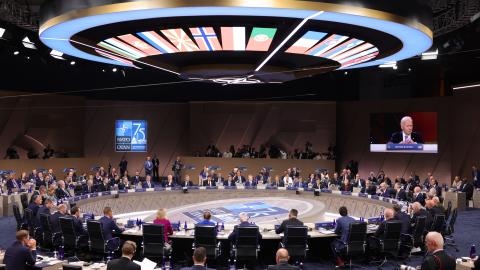The Diplomat author Mercy Kuo regularly engages subject-matter experts, policy practitioners, and strategic thinkers across the globe for their diverse insights into U.S. Asia policy. This conversation with Dr. Liselotte Odgaard, a senior fellow at Hudson Institute in Washington, D.C.,is the 423rd in“The Trans-Pacific View Insight Series.” Dr. Odgaard expresses gratitude to the Sasakawa Peace Foundation for supporting her research on NATO-Indo-Pacific cooperation.
Analyze the top three takeaways of the recent NATO Summit in Washington, D.C.
Ukraine figured prominently at the NATO summit in Washington, D.C., July 9-11, 2024, perhaps to highlight that when facing major threats to the transatlantic alliance, unity seems to trump discord. As NATO takes over coordination responsibilities in Ukraine from the United States, a new command structure, strengthened deterrence and defense along NATO’s eastern flank, and operationalization of regional defense plans will also be implemented. These decisions imply that Washington delegates much of the heavy lifting regarding European security to European capitals, although the United States as a major NATO member remains in the driver’s seat.
NATO leaders and partners alike emphasized that the war in Europe today can be tomorrow’s reality in the Indo-Pacific. U.S. allies such as Japan, Australia, New Zealand, and South Korea are keen to expand cooperation with NATO, hence their commitment to continued support for Ukraine at the 2024 NATO summit. One reason is a complex pattern of strengthened Chinese-Russian-Iranian-North Korean strategic cooperation that spans the transatlantic and Indo-Pacific theaters. Another, tacit, reason, is that U.S. Indo-Pacific allies face the same challenge of having to bear more responsibility for security and defense in their home region in the future.
Building a strong defense industrial base and protecting strategic supply lines is to be accelerated across the transatlantic alliance because such efforts have a major deterrent effect on authoritarian states such as Russia and China. As part of these efforts, NATO’s summit declaration announces flagship projects in cyber defense, countering disinformation, and technology.
Identify the key outcomes for NATO’s Indo-Pacific partners at the summit.
For Japan, South Korea, Australia, and New Zealand the key outcomes of the 2024 NATO summit are the strengthening of dialogue to handle cross-regional challenges and the flagship project focused on cyber and technology. NATO’s Indo-Pacific partners hope to work more closely with the transatlantic alliance on shared security interests, but not only that. South Korea hopes that its defense industry can further contribute to building a strong defense industrial base in North America and Europe. Japan looks to South Korea to learn from its increased sales to transatlantic allies, hoping to slowly but surely follow in its footsteps and expand Japan’s defense industry through exports to NATO allies to make up for U.S. demands for increased defense expenditures and to strengthen its national industrial base.
What was the main messaging of the NATO-Indo-Pacific Partnership and its targeted audiences?
The main message of the NATO-Indo-Pacific Partnership was to signal to China, Russia, Iran, North Korea, and other authoritarian states that the partnership stands united in supporting Ukraine in the war with Russia, recognizing that Ukraine’s defeat would have terrible consequences in the Indo-Pacific. Support for Ukraine’s war is considered a key deterrent of authoritarian states threatening democracies and a free and open world order.
Threats and challenges are increasingly global, making closer NATO cooperation with its Indo-Pacific partners a necessity. According to the deputy U.S. secretary of state, the next chapter in this journey is to explore Southeast Asian countries’ interest in dialogue and cooperation with NATO.
Examine Beijing’s narrative construct of an “Asian NATO” to legitimize its geopolitical agenda.
China has watched with concern NATO’s efforts at ”going global.” NATO’s Indo-Pacific partners are not strategic in the sense that they are expected to contribute to the alliance’s military-strategic concepts and plans or strengthen its defenses. Instead, they are cooperative security partners that signify NATO’s conceptual enlargement process. However, they strengthen U.S. commitment to the alliance and the resolve to counter Chinese security challenges across the European and Indo-Pacific theaters.
China’s response to this emerging two-front dilemma has been to step up strategic cooperation with Russia and other adversaries of the West such as Iran. China publicly accuses NATO of assuming a posture of going wherever it needs to go and going wherever it wants to go, calling the transatlantic alliance a systemic challenge that threatens world security and stability.
China is not overly concerned about NATO going global in itself. It is the coordinated response to China’s advances that it considers a formidable security challenge. These are efforts between entities that are aligned with the United States, including the European Union, NATO, and its Indo-Pacific partners, to develop new capabilities across multiple military and non-military domains.
In turn, China strengthens its flexible network of strategic partners in Eurasia and in the Global South, including expanding the security component of these partnerships. Reflecting Chinese entrapment concerns, the partnerships can be adjusted to international developments and allow China to keep its options open with regard to which patterns to prioritize in coming decades.
Assess the impact of the NATO summit on China and Russia.
NATO views the deepening Russian-Chinese strategic partnership and their mutually reinforcing attempts to undercut and reshape the rules-based international order as a cause for profound concern, confronting Euro-Atlantic allies with hybrid, cyber, space, and other threats and malicious activities from state and non-state actors. Increased defense spending and cooperation with partners beyond NATO’s area of operation are likely to confirm to Russia and China that strategic cooperation is necessary to counter resolve within the U.S. alliance system to meet threats and challenges from a position of allied strength and resolve.
However, it may also lead Beijing to watch more carefully if China risks being drawn into conflicts arising from Moscow’s geostrategic policies that run counter to China’s interests in maintaining a strategic foothold in Europe and the Global South without engaging in warfare. Russia pursues its own agenda from the Mediterranean to the Arctic, and from West Africa to the Middle East. Although Beijing is enhancing its strategic foothold by hybrid means, especially in the Indo-Pacific, the People’s Liberation Army’s lack of warfighting experience and widespread corruption issues may cause Beijing to carefully avoid actions that might trigger the use of deadly force involving the United States.
At present, China’s priorities seem to be addressing the structural problems in the Chinese economy, such as restoring the housing market, strengthening the job market, and pushing for global technological leadership in key sectors such as artificial intelligence and quantum computing. Such priorities are ill-suited to protracted warfare.



















